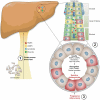The dynamic biliary epithelia: molecules, pathways, and disease
- PMID: 23085249
- PMCID: PMC3831345
- DOI: 10.1016/j.jhep.2012.10.011
The dynamic biliary epithelia: molecules, pathways, and disease
Abstract
Cholangiocytes, the cells lining bile ducts, are a heterogenous, highly dynamic population of epithelial cells. While these cells comprise a small fraction of the total cellular component of the liver, they perform the essential role of bile modification and transport of biliary and blood constituents. From a pathophysiological standpoint, cholangiocytes are the target of a diverse group of biliary disorders, collectively referred to as the cholangiopathies. To date, the cause of most cholangiopathies remains obscure. It is known, however, that cholangiocytes exist in an environment rich in potential mediators of cellular injury, express receptors that recognize potential injurious insults, and participate in portal tract repair processes following hepatic injury. As such, cholangiocytes may not be only a passive target, but are likely directly and actively involved in the pathogenesis of cholangiopathies. Here, we briefly summarize the characteristics of the reactive cholangiocyte and cholangiocyte responses to potentially injurious endogenous and exogenous molecules, and in addition, present emerging concepts in our understanding of the etiopathogenesis of several cholangiopathies.
Copyright © 2012 European Association for the Study of the Liver. Published by Elsevier B.V. All rights reserved.
Figures


References
-
- Marzioni M, Glaser SS, Francis H, Phinizy JL, LeSage G, Alpini G. Functional heterogeneity of cholangiocytes. Semin Liver Dis. 2002;22:227–240. - PubMed
-
- Alpini G, Ueno Y, Glaser SS, Marzioni M, Phinizy JL, Francis H, et al. Bile acid feeding increased proliferative activity and apical bile acid transporter expression in both small and large rat cholangiocytes. Hepatology. 2001;34:868–876. - PubMed
-
- Lesage G, Glaser S, Ueno Y, Alvaro D, Baiocchi L, Kanno N, et al. Regression of cholangiocyte proliferation after cessation of ANIT feeding is coupled with increased apoptosis. Am J Physiol Gastrointest Liver Physiol. 2001;281:G182–G190. - PubMed
-
- Lazaridis KN, Strazzabosco M, Larusso NF. The cholangiopathies: disorders of biliary epithelia. Gastroenterology. 2004;127:1565–1577. - PubMed
Publication types
MeSH terms
Substances
Grants and funding
LinkOut - more resources
Full Text Sources
Other Literature Sources
Medical
Research Materials

